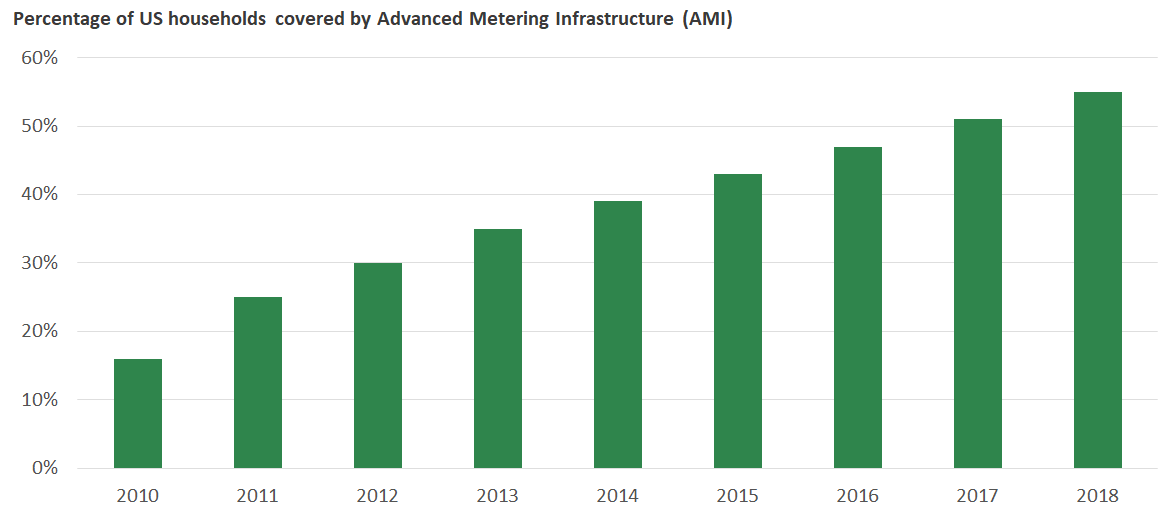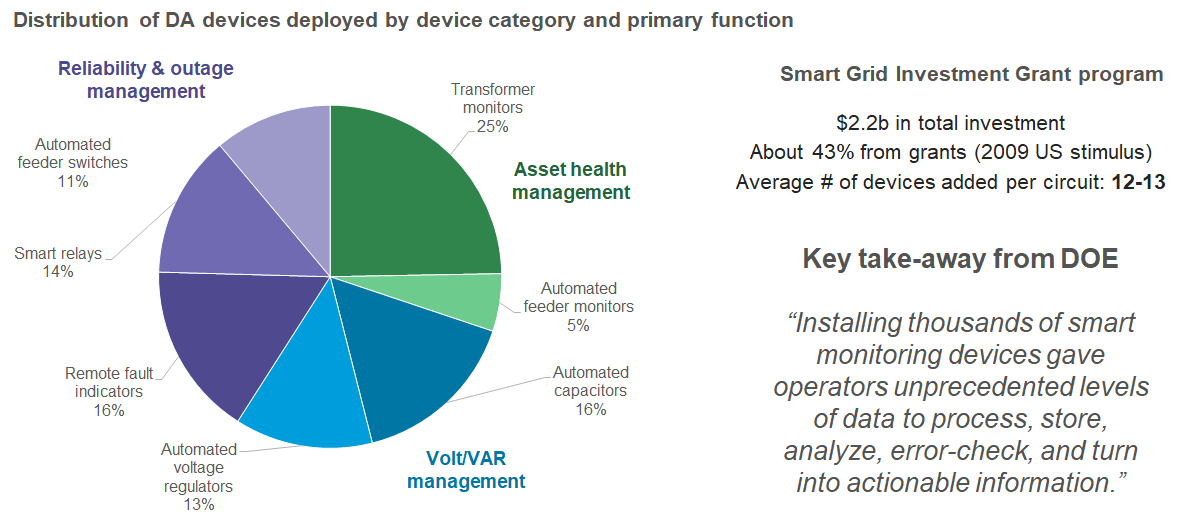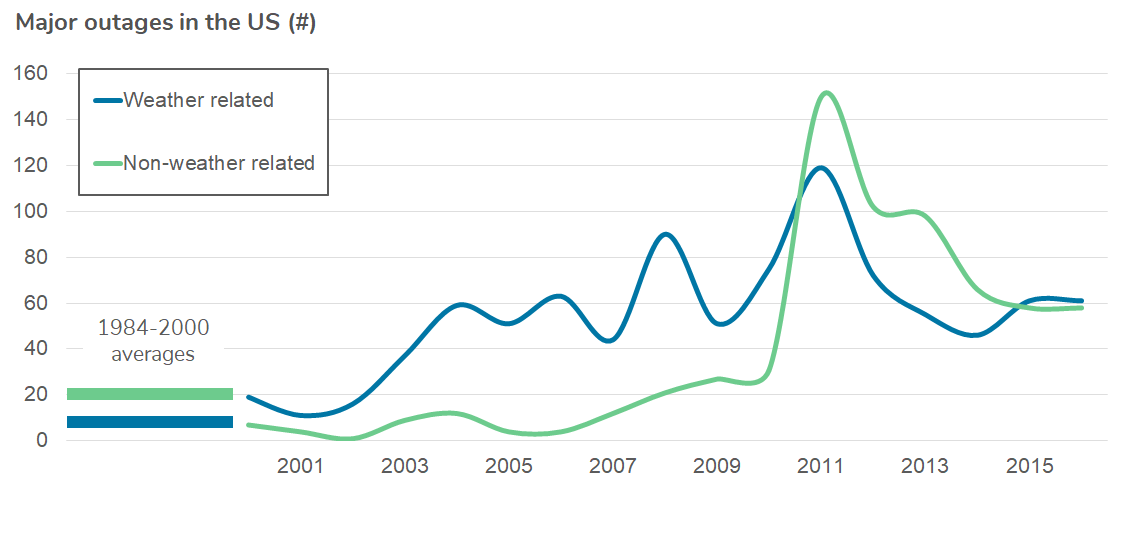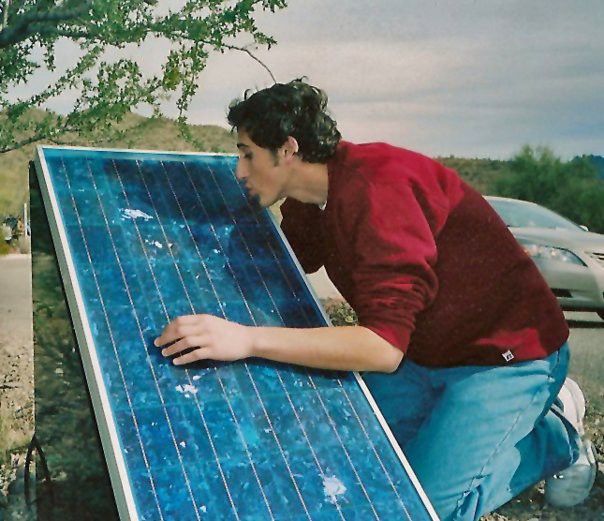Energy Impact Partners: A primer on the next three decades of the energy transition - Part 5
Energy Impact Partners research lead, Andy Lubershane, releases a five-part series examining technologies needed to fully decarbonize the energy system, relying on as few technology “moonshots” as possible.

This is the last article of a five-part series examining the technology we’ll need to fully decarbonize our energy system, relying on as few technology “moonshots” as possible.
I. The Electric Future We Need
II. Two Storage Technology Revolutions
III. Cheaper, Deeper Offshore Wind: completing our renewable resource portfolio
V. The Grid of the Future
Choose almost any definition for the word “complex”, and you’ll find that the most complex machine ever designed and operated by humans is an electrical grid — specifically, at this point in time, the massive grid covering the eastern half of the United States, known as the “Eastern Interconnect”.
This unfathomable machine transmits electricity from thousands of power plants, through hundreds of thousands of switches and circuit breakers and transformers, across millions of miles of transmission and distribution lines, into the messy wiring of homes and buildings, and onward into tens of billions of individual devices that vary in their consumption needs from smart phones to elevators. It performs this feat in real time, all the time, with little room for error, with greater than 99.8% reliability. Every part of the system is dependent on the weather, from the energy produced by wind turbines, to the price of natural gas — which flows through an interconnected network of pipelines — to the operation of millions of air conditioning systems. There is no single operator; instead, dozens of entities must coordinate to make sure everything stays in tune.
Did I mention that this system has been built up over more than a century, patched and upgraded over time like the Ship of Theseus? In my view, it’s the greatest example of a “public-private partnership” in history — balancing the needs of private capital with the needs of society via layers of regulatory authority from municipalities, to states, to the federal government. (Yes, I’m clearly enamored.)
In the next three decades, we might need to double the amount of energy this system delivers, while asking operators to relinquish the most potent lever over which they’ve always exercised control: the ability to turn power plants on and off at will. We need to do this while the system becomes ever more critical; as everything we do becomes utterly dependent on the uninterrupted flow of electrons.
I’m pleased to say that out of the four technology categories I’ve covered in this series, the technology that we’ll require to manage the grid requires the least amount of breakthrough innovation. For the most part, the individual components we’ll come to rely on already exist today; it’s the implementation of all of these components into a cohesive system that’s the rub. There’s no single, definitive answer key. Instead, the operators of every part of the system will need to assemble the best suite of components they can find, piecemeal.
There are, of course, common themes among the next generation of grid management tools that are worth highlighting. I’ll begin with four. (These happen to be four of the themes into which my company, Energy Impact Partners, seeks to invest.)
1. Visibility: Most people outside of the electric power industry tend to overestimate the amount of visibility that grid operators already have today. Adding more real-time visibility, especially in remote parts of the transmission system and towards the edge of the distribution network, will be critical.
2. Distributed control: As operators lose control over centralized power generation, one way they can make up for that loss is to exercise more control — or at least more influence — over the way devices towards the edge of the grid are operated. Those devices include a host of products that will not be owned by the utility directly; instead they’ll be owned and operated by end users, located (in industry parlance) “behind the meter” — i.e. inside of homes and businesses. I’ve previously written a whole article on this topic, so I won’t go into tons of detail here.
3. Resilience: As we electrify more and more of our economy, the reliability of electricity supply will become ever more critical. Fortunately, day-to-day reliability isn’t really an issue — as I mentioned above, the grid is currently up and running more than 99.8% of the time here in the US. What’s at stake is the resiliency of the system during abnormal conditions. Unfortunately, the grid faces a growing risk of ‘abnormal conditions’ due to extreme weather, cyberattacks, and potentially other national security threats — not to mention the inherent risk of depending on a more complex, interdependent system. (Cue Dr. Malcom’s water on the hand trick…) Hence, building more resiliency into that system is a top priority.
4. Integration: As described above, the grid is already a system of systems. It will become even more-so as we layer on new data flowing among a growing array of sensors and controllers, plus enhanced decision-support and automation tools. These disparate systems need to be tightly interconnected, both physically and digitally.
The story of visibility & control through the story of the meter:
Think back once more to a decade ago. The meter on the side of your house was probably just that: a meter meant to accurately measure the amount of electricity you consumed. In order to gather that information to bill you for your usage, a utility worker had to walk up to your house and read the gauge on the meter, in-person.
Hence, the meter was just a billing tool, and a pretty crude one at that. It provided no real time visibility into the status of electricity flows on the network. In fact, the utility’s real-time vision was probably limited to a few monitoring points ‘upstream’ on the grid, at larger substations feeding hundreds to thousands of homes and businesses.
At that time, if you were to (illegally) sneak a large solar array onto your rooftop and tie it into the grid, your utility probably wouldn’t have noticed unless one of its extra-diligent employees reported seeing the panels. If you were to buy a shiny new Tesla, the utility might notice that your total monthly consumption had more than doubled, and might surmise that you’d bought an EV; but it would have no idea whether you charged your vehicle a little bit every day, or a lot once a week; and no means of encouraging you to charge after, say, 10 pm at night when there’s less demand for electricity.
Today, more likely than not, your electric meter is already a much more useful device. About a quarter of households now have a meter that can be read remotely, via short-range radio, by a utility worker driving past the house. More importantly, more than 55% of household meters are what’s considered “smart”, which means they can automatically send data to the utility via a private wireless network — no drive-by required.

US Energy Information Administration
The cost savings from avoiding manual meter-reads were an important driver for utilities making the upgrade to smart meters. (Also, it’s important to point out that a significant portion of the first generation of smart meters were also funded by the American Recovery and Reinvestment Act — the ‘stimulus’ bill passed in 2009.) But in addition to a more efficient billing process, smart meters have another major benefit — one that has yet to be fully realized. They’re capable of collecting data on energy consumption at least hourly — in some cases every five minutes — which represents a game-changer relative to the monthly readings of the past.
This capability has transformative potential. It enables utilities to make much more accurate, high-resolution forecasts of energy demand; to study and prepare for consumer adoption of new distributed energy technology; and, most importantly, to calculate the precise cost to serve each customer based on their individual ‘load profile’ — meaning their specific pattern of energy consumption over the course of each day.
The cost of delivering electricity to consumers varies substantially from hour to hour — sometimes even from minute to minute — and costs are expected to become significantly more volatile as wind & solar take over from coal & gas. Smart meters make it possible for utilities to allocate these costs to their customers using so-called ‘time-of-use’ price signals. These price signals might encourage consumers to take action on their own during the most expensive periods; or, more likely, they’ll encourage consumers to install smart devices — e.g. thermostats, hot water controls, and EV chargers — that can automatically tweak various set points and schedules in order to minimize cost without seriously sacrificing comfort or convenience.
Some consumers might want to sign up for a more comprehensive ‘energy management’ plan from their utility or another third-party “energy service provider” who’s equipped to take care of all this stuff on their behalf.
Hence, smart meters offer a lot of value. However, most of the meters currently installed fall short of providing all of the visibility grid operators are going to require to manage a much more dynamic, bidirectional grid. For starters, most meters today don’t provide real-time data; there’s usually a 6–12 hour lag (at least!) between when meters record data and when the utility receives it. More real-time data from at least a portion of customers seems like it will probably become essential.
Secondly, even if meter data were delivered in real time, it’s insufficient for assessing the configuration, capacity, and health of many critical elements of the overall system. The unsung heroes of the electrical grid — going by arcane names like transformers, capacitors, circuit breakers, and switchgear — still offer surprisingly limited real-time visibility today. They’ll undoubtedly need to be joined by additional points of sensing and control.
Some of these new sensors might be housed within next-generation meters; others may come as standard features on next-gen solar or battery inverters; and still more might be sprinkled strategically across the network. Taking a first pass at this ‘sprinkling’, a major Department of Energy “smart grid” program helped hundreds of utilities fund the deployment of connected devices across a select group of electric distribution circuits. I’ve estimated that those devices represent about a 10X increase in the volume of data flowing to and from the grid in those areas. Hence, the results of this program are a valuable benchmark for envisioning the future state of the grid.

Source: “Distribution Automation: Results from the Smart Grid Investment Grant Program”, US DOE, 2016
A grid of ‘microgrids’? The road to resilience…
Today, only about 4% of households have backup power generators. The market penetration of backup systems is a little higher for commercial buildings, and much higher for industrial consumers, for whom a loss of power might actually be dangerous (unsurprisingly, it’s 100% for data centers). But so far, the rest of us have demonstrated a pretty low willingness to pay for backup power; we’ve effectively signaled to the market that we’re willing to tolerate occasional candles and flashlights.
That’s today. But 30 years from now, when our cars are electric, our heating systems are electric, our stoves are electric, and everything we do both at home and at work depends on the internet (which is, of course, electric) — I expect we’ll feel differently.
We might also feel differently because the risk of major, extended power outages appears to be rising.

Sources: “Blackout: Extreme Weather, Climate Change, and Power Outages”, Climate Central, 2014; “Data on Major Power Outage Events in the Continental US”, Mukherjee et al, June 2018
The data above shows that utilities have done a pretty good job keeping the grid up and running during normal conditions. Unfortunately, climate change is making their jobs harder. From wildfires in the West, to hurricanes in the Southeast, to ice storms in the Northeast, the grid is becoming increasingly threatened. Investing in physical “hardening” of grid infrastructure is expected become a more and more expensive way to ensure reliable power.
Of course, there’s also tremendous, yet difficult-to-quantify value in increasing the resilience of our energy supply against the threat of deliberate attacks. Those attacks could hypothetically be physical; but it seems more likely in the decades to come that they’ll be virtual. Worryingly, utilities have already become a testing ground for cyberattacks on critical infrastructure.
Hence, in addition to day-to-day reliability, we also need to invest in resilience. One way to do that is through emergency preparedness — bolstering the capability of grid operators to respond decisively to various types of events. But, at the end of the day, the best way to build resilience into the system is to give portions of that system the capacity for self-sustenance — meaning the ability to act as energy ‘islands’ unto themselves for short periods, at least until service on the larger grid can be restored.
These ‘microgrids’ can hypothetically be as small as an individual household, or as large as an entire neighborhood served by a single electric distribution circuit. Currently, they tend to be most reliant on diesel or natural gas generators; but increasingly I expect they’ll begin to incorporate distributed solar, batteries, and demand management capabilities (e.g. smart appliances and circuit breakers).
This is how the microgrid concept really starts to sing. If the trifecta of solar, batteries, and demand management can be set up to play a dual role — as integrated, holistic, system resources during normal conditions; and as backup power resources during larger grid outages — they’ll satisfy three vital needs at once. We’ll actually get three birds with one stone: clean energy, resilience, and more efficient everyday operations.
Taking this concept to its logical extreme: In 30 years we might very well end up with a sort of “Borg” of an electric power system — a grid composed of many microgrids. And that brings me to one final technology theme: integration.
Perhaps the single most difficult challenge facing grid operators in the coming decade is making sure all of the disparate components and subsystems I’ve described above work well together. Increasingly, the core of that challenge is becoming a digital one, because underlying the physical grid is a rapidly expanding foundation of software. This software infrastructure needs to be as robust as the physical grid it supports. But it needs to be even more flexible, as software evolves much quicker than poles and wires. Digital grid components may need to be replaced 10 times before their physical counterparts!
Fortunately, the electricity industry is not the first industry to undergo this type of digital transformation. We can draw on lessons learned and best-in-class tools that have already been refined in other sectors — for example, next-generation databases; data preparation tools; and so-called “integration platforms”.
Hence, my best advice to utilities and other power system operators is this: the most important hires you’ll make in the next five years are the ones with something akin to “digital architect” in the job title. My advice to students considering a career in clean energy: go learn the stuff that will allow you to apply for ‘digital architect’ jobs.
Conclusion:

Me, in 2007, with a lot less understanding of the energy system, but a lot more hair
In this series, I’ve laid out a vision for the energy transition our society needs to undertake over the next three decades. I’ve focused on the areas where new technology is likely to make the biggest difference in our ability to make the leap to nearly 100% clean energy. I’ve tried not to be overly sanguine about the significant technical obstacles we have yet to overcome, but to some degree I can’t help myself.
I feel like a little optimism is warranted. The story of the past decade of clean energy taught me not to bet against the one-two-punch of human ingenuity & economies of scale.
And yet, we also need to be realistic. As an analyst in the energy industry, I’ve spent my career so far writing about industry trends. I’ve finished countless sentences with the phrase “by 2020” or “by the end of the decade”. And yet, it’s taken me personally about a decade of employing these markers to understand at a visceral level what they mean.
In human time, ten years is a long stretch. I’ve gotten married, and moved from Michigan, to Massachusetts, then to Maine. I’ve changed employers; lost a lot of hair; played a lot of board games; and had a baby. But I’ve come to understand that in energy industry time — and in climate time — a decade is alarmingly short.
Three decades will pass all of us by very quickly.

_400_250_s_c1.png)




